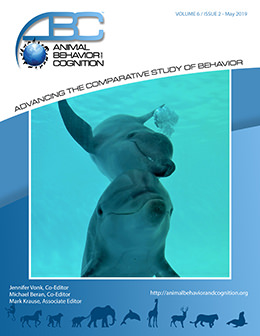Vol 6, Issue 2, May 2019
Bubble Trails, Bursts, Rings, and More: A Review of Multiple Bubble Types Produced by Cetaceans
Citation
Moreno, K. R., & Macgregor, R. P. (2019). Bubble trails, bursts, rings, and more: A review of multiple bubble types produced by cetaceans. Animal Behavior and Cognition, 6(2), 105–126. https://doi.org/10.26451/abc.06.02.03.2019
Abstract
Reports of cetacean bubble production spanning several decades have begun to document occurrences and possible functions of this unique behavior. These observations can be grouped by their physical features into three main categories: bubble trails, bubble bursts, and bubble rings, though some observations indicate the need for additional categories and others simply report on bubbles generally. Bubble trails consist of a long, thin stream, and are often seen in stressful situations, agonistic interactions, to initiate synchrony, and with vocal behaviors. Bubble bursts consist of a large volume of air in a cloud-like clustering, and are primarily observed in agonistic situations or attributed to surprise, excitement, interest, or curiosity. They are also seen in sexual and other social situations. This category may include a less commonly reported type, the large singular bubble. Bubble rings consist of air forming a torus, and are almost exclusively produced as objects for play, with exceptions occurring during agonistic interactions. Additional possible types include scant bubble or blowhole drip, and bubble cloud from the mouth. Much is still unknown regarding bubble functions, most notably whether production is voluntary. In this review, we summarize findings throughout the literature, including terminology and behavioral use. We also discuss issues within the literature and provide suggestions for future research. Through this, we hope to improve understanding, encourage more studies and descriptions of bubble production, and ultimately support using bubble production as an indicator behavior for practical applications, including welfare and conservation.
Keywords
Bubble, Bubble trail, Bubble burst, Bubble ring, Cetacean behavior
